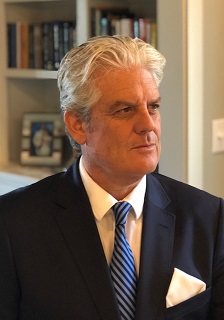From the CEO – August 2019
 Dear Clients,
Dear Clients,
Part of the accepted wisdom of serious efforts at political risk forecasting is that the enterprise requires a relevant and sufficiently comprehensive series of metrics against which a larger picture of overall risk can be acquired. So – to use a couple of risk variables – when assessing a country’s business and investment landscape, the security of public and private contractual obligations (including debt payments), transfer and conversion policies, along with stability of other parts of the operating environment (e.g., social turmoil) should be considered.
Obviously, there is more that should be considered; and PRS uses over 20 general categories of political risk alone (along with sub-components and qualifying criteria). As such, degrees of risk are (and ought to be) assessed and quantified (for pricing of insurance, valuation and debt, as well as for cross jurisdictional analyses). Any form of inquiry that deviates significantly from this can be consigned to the categories of (learned) opinion or ‘spin.’
Yet to make sense of the currents of risk and therefore a realistic forecast requires a meaningful trajectory of data, patterns of causality, which can be supported by a politically relevant consensus. For example, dictatorial (or democratically unresponsive) regimes tend to continue for some time, supported by various apparatum, including unified security forces, powerful foreign and local capital interests, healthy fiscal and current accounts, to name a few. (Have a look at Jacques Barzun’s chapter, “The Monarch’s Revolution” in From Dawn to Decadence, puts this into historical context in his chapter titled, “The Monarch’s Revolution”).
When these are disrupted, sometimes unexpectedly, then the notion of outliers can come into play (we now refer to these items sometimes as Black Swans, courtesy of Nassim Taleb, whose works we still love revisiting), which tend to confound the usual pattern of analysis until some general rule can be ascertained from them. That rule can then be inserted into the arsenal of available analytical tools.
The idea of consensus is interesting because it reminds us of one of the books we are currently reading, The Last Leonardo, by Ben Lewis.
As some may know, the ‘last’ refers to the Salvator Mundi, da Vinci’s portrait of Christ that art dealers had searched in vain for years. The problem with the picture that was ultimately sold via Christie’s for $450 million was that at least 20 similar versions had been produced during Leonardo’s lifetime; his assistants usually produced this type of ‘stock’ subject matter; the painting had been restored so significantly over the years that it was questionable ‘how much’ da Vinci was left, assuming he was the sole artist on the piece. Moreover, the painting had been offered for sale to a number of presumably favorable buyers, including the Qatari Royal Family, the Hermitage in St Petersburg, and the Getty Museum, to name a few. All passed on the purchase.
Yet sides lined up in the attribution process, and in a highly unusual move, the National Gallery in London, in 2011, decided to include the “Salvator Mundi” in its exhibition on Leonardo. In the art world, inclusion of this sort provides an implicit endorsement of the work and tends to boost the value of the work. This is why it is generally looked upon negatively.
How the painting was marketed and sold by Christie’s is fascinating; and if one is curious the buyer was reported as Crown Prince Mohammed bin Salman of Saudi Arabia (there are rumors that President Trump’s son-in-law, Jared Kushner advised the Crown Prince). The Crown Prince was supposed to loan the painting to the Louvre Abu Dhabi but that did not materialize for a number of possible reasons.
At the moment, the “Salvator Mundi” is located in a high-security vault in Geneva Freeport.
The notions of outliers, and the consensus that formed to assign the picture to Leonardo, have some parallels with the recent trade war between the US and China, President Trump’s tweets, and the wild swings in the equity markets, globally.
It is well-known that the president’s re-election hopes depend largely on the state of the economy and the stock market. Indeed, some time ago, Credit Suisse published a report noting the correlation between Trump’s popularity and stock and bond prices. This is the consensus.
Yet at the same time, the president displays a now vexing tendency to tweet major policy changes, usually without warning, which sends the markets in different directions, adding to the overall volatility (and great gains for the VIX!). Notwithstanding arguments about equity valuations, the business cycle, and inverted yield curves, the president’s moves do very little to help investors allocate portfolios, unless, of course, a longer-term vision is employed. The tweets are the outliers.
Given this, and to round out the analysis, the issue now is one of the president’s credibility. Last week, following China’s decision to impose some tariffs on US exports, the president responded quickly with his own version of higher tariffs, which sent the equity markets downhill, further compressing bond yields, and putting pressure on various currencies (especially in the emerging markets).
At the G7 meeting this week in Biarritz, Trump adopted a more conciliatory tone on the China trade battle, suggesting that ‘…they want to make a deal,’ and that a delay or cancellation to the planned tariffs were ‘possible.’ Trump also mentioned that Chinese officials had called US trade officials with the news of their desire to make a deal, yet there was no confirmation of such calls. When pressed, the president responded by saying, “I don’t want to talk about calls. We’ve had calls. We’ve had calls at the highest levels.”
Turning to the world of political risk, some notable developments were covered by our analysts this month. In Argentina, the recent market rout has itself heightened the risk of a default, as the steep fall in the value of the peso has contributed to a steep rise in the cost of Argentina’s large pile of dollar-denominated debt. In 2011, the public-sector debt burden fell below 40% of GDP. In July 2018, amid negotiations for a bailout package, the IMF forecast that the debt-to-GDP ratio would peak at 65% before falling to 56% by the expiration of the bailout program in 2021. However, the combination of peso depreciation and a shrinking GDP pushed the figure above 86% last year, and the ratio is now certain of hitting triple digits this year.
For his part, President Macri has expressed confidence that he can still win the presidential election, pointing to the market turmoil as evidence for the case against electing Fernández. Indeed, that thousands have poured into the streets of Buenos Aires in support of his re-election is an encouraging sign.
However, for the average voter, the near-term manifestations of the volatility will be a worsening of the same negative factors—high inflation, an economic downturn, and fiscal austerity—that have raised doubts about Macri’s chances of winning a second term, and his status as the incumbent will diminish the resonance of a campaign based on the principle of “the least bad option.”
Over in China, ongoing trade frictions combined with the country’s ultimate aim of rebalancing the economy from investment to consumption will likely continue the downward slide in GDP growth which slipped to 6.2% year on year in real terms during the second quarter, and is still seen as the achievable target for 2019, furthering the gradual slowdown in official growth from 6.6% in 2018 and 6.8% in the preceding year. Although authorities have taken measures to address credit risks, partially by introducing restrictions on housing demand, contributing to the slide in property prices in June, the trade dispute is encouraging more infrastructure investment to help offset the downturn in exports undermining domestic production, with domestic demand further bolstered by tax cuts and credit growth driving private consumption higher.
And in Russia, in the face of a series of ongoing protests against Putin’s regime, exports are down compared to last year amid increased global trade risks, activity in the construction industry has stalled in the first half of 2019 following the completion of major projects related to the World Cup, and retail sales growth slowed to 1.4% (year-on-year) in May and June, despite falling unemployment, as a combination of sluggish wage growth, and increase in the value-added tax (VAT) from 18% to 20% at the start of the year, and inflation eroded household disposable income.
With high frequency indicators revealing little cause to expect a sustained improvement in economic activity and the headline inflation rate slowing easing toward the 4% target rate from a high of 5.3% (year-on-year) in March, the Central Bank of Russia (CBR) cut the key interest rate for the second time since the start of the year in July, a quarter-point reduction that trimmed the rate to 7.25%. A rate cut announced by the US Federal Reserve in late July confirmed the adoption of an easing bias by US monetary authorities that together with the general weakness of the Russian economy and the disinflation trend signals the possibility of additional policy loosening by the CBR later in the year.
One of the items we have in our new ICRG Investir newsletter (contact the PRS office for your copy) are the best and worst performers over the month and over the course of the year. We base the list on changes in composite ratings. The list gives a general context to our ratings and highlights some movements in country risk that might not be covered by the mainstream financial press. For August, the changes are:
Best Performers (month-on-month)
Greece (2.0)
Lebanon (2.0)
Ukraine (1.5)
Worst Performers (month-on-month)
Hong Kong (1.5)
Zimbabwe (1.0)
Burkina Faso (1.0)
Best Performers (year-on-year)
Qatar (5.0)
Angola (5.0)
Congo (4.8)
Worst Performers (year-on-year)
Haiti (5.8)
Zambia (5.8)
Iran (3.5)
As always, our ICRG data has interesting real-world applications. A study published in the Financial Analysts Journal showed that ICRG’s composite risk measure has considerable power to identify high and low return portfolios. On a risk adjusted basis, the hedge strategy (buy upgrades and sell downgrades) based on composite risk has an (annualized) alpha of 1070bp per year when all countries are examined.
And in the academic world, advancing literature is always key for our work. A recent IMF Working Paper found that a higher quality of governance (using ICRG risk metrics of Corruption, Law and Order, and Bureaucratic Quality) was associated with a higher degree of export diversification. Poorer governance was associated with export concentration in fewer products. Interestingly, a country’s measure of democracy did not appear to be associated significantly with diversification!
Finally, we would like to welcome our new clients this month, including a number of US and European-based institutional investors and hedge funds (with a collective total of over $200 billion in AUM), along with the University of Colorado (Denver), the Central Bank of the Republic of Turkey, Rice University, Wake Forest University, and various global consultancies. Thank you for your trust and support!

Chief Executive

PRS INSIGHTS
Moving beyond current opinions, a seasoned look into the most pressing issues affecting geopolitical risk today.
EXPLORE INSIGHTS SUBSCRIBE TO INSIGHTS
